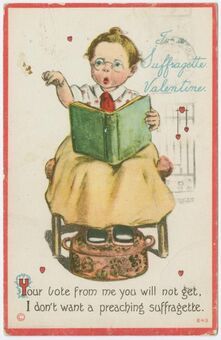
New York Public Library Digital Collections During the Victorian era, when store-bought valentines replaced handmade ones, the buyer had two choices: hearts-and-flowers cards expressing love and admiration or valentines with caricatures and insulting verses ridiculing the recipient.
The typical format of the vinegar valentine was a caricature of the recipient and a short verse at the bottom. Men sent vinegar valentines to damsels who’d dared turn them down or to women they were throwing over. Likewise, women sent cease-and-desist valentines to men who were pursuing them.
The vinegar valentines weren't only for men and women in failed courtships. People could buy valentines to chastise the behavior of relatives, neighbors, and acquaintances.

The cards chided women for looking and dressing too well, or for not paying enough attention to their appearance. They were criticized for frowning too much or smiling too broadly. Women who campaigned for the right to vote were prime targets.
Men were also the butt of vinegar valentines, criticized for drunkenness, vanity, stinginess, and stupidity.
Nasty valentines poked fun at people’s physical traits or misfortunes: their age, excessive weight, or widowed status. The worst cards suggested suicide. The image on one of them depicts an oncoming train with the verse:
Oh miserable lonely wretch! / Despised by all who know you; / Haste, haste, your days to end – this sketch / The quickest way will show you!
View more examples of vinegar valentines and read how they became popular and eventually died out in my
article in CrimeReads.
Published on February 12, 2021 09:54
 newest »
newest »
 newest »
newest »
 Those menus are outstanding. Those cooks didn't have all the conveniences we have to cook the food but they did have real butter and flour with no additives.
Those menus are outstanding. Those cooks didn't have all the conveniences we have to cook the food but they did have real butter and flour with no additives.

 New York Public Library Digital Collections During the Victorian era, when store-bought valentines replaced handmade ones, the buyer had two choices: hearts-and-flowers cards expressing love and admiration or valentines with caricatures and insulting verses ridiculing the recipient.
New York Public Library Digital Collections During the Victorian era, when store-bought valentines replaced handmade ones, the buyer had two choices: hearts-and-flowers cards expressing love and admiration or valentines with caricatures and insulting verses ridiculing the recipient. 


